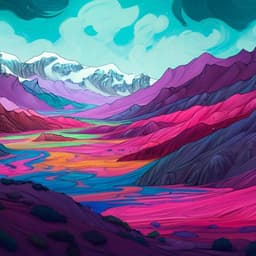
Earth Sciences
Increased Asian aerosols drive a slowdown of Atlantic Meridional Overturning Circulation
F. Liu, X. Li, et al.
Discover how increased Asian anthropogenic aerosols are influencing the Atlantic Meridional Overturning Circulation (AMOC) slowdown. This groundbreaking research by Fukai Liu, Xun Li, Yiyong Luo, Wenju Cai, Jian Lu, Xiao-Tong Zheng, Sarah M. Kang, Hai Wang, and Lei Zhou reveals the complex interactions between air pollution and climate systems, emphasizing the urgent need for emission reductions in Asia.
~3 min • Beginner • English
Introduction
The Atlantic Meridional Overturning Circulation (AMOC) is a key component of the climate system, transporting large amounts of heat to the North Atlantic and influencing global climate. Multiple lines of evidence indicate that the AMOC has weakened in recent decades, and climate models project further slowdown under continued greenhouse gas forcing. Beyond greenhouse gases, anthropogenic aerosols (AAs) exert strong, spatially heterogeneous radiative forcing and have played an important role in historical AMOC variability. Global aerosol emissions evolved in two stages: a general increase prior to the late 1980s, followed by stabilization due to reductions in Europe and North America, while emissions over South and East Asia continued to rise. Prior studies and DAMIP single-forcing simulations suggest AAs strengthened the AMOC before the mid-1990s and weakened it thereafter, often attributed to decreased aerosols over the North Atlantic sector. However, the impact of increasing Asian aerosols remained uncertain. This study asks whether and how increased Asian AAs, despite their local radiative cooling, affect the AMOC and through what mechanisms, with particular attention to potential atmospheric teleconnections and their effect on North Atlantic surface forcing and deep-water formation.
Literature Review
Prior work has established the AMOC’s climatic importance and suggested a modern-era decline, though with ongoing debate. CMIP-class models project future weakening with elevated greenhouse gases. Anthropogenic aerosols, due to their short lifetimes and spatial inhomogeneity, have been implicated in 20th-century AMOC variability: DAMIP and other studies show a two-stage aerosol influence, with strengthening before the mid-1990s and weakening thereafter. Reductions in North American and European aerosols have been linked to AMOC weakening through local radiative heating and density reductions in the North Atlantic. Meanwhile, increasing Asian aerosols can alter large-scale atmospheric circulation, including equatorward shifts of the westerly jet via stationary Rossby waves. Recent literature highlights zonal shifts in aerosol distributions, their roles in Eurasian and North Atlantic circulation changes, and model-dependent mechanisms by which aerosols modulate ocean circulation and water-mass transformation. Nonetheless, the specific AMOC response to increased Asian aerosols and the underlying teleconnection pathways remained unclear, motivating the present targeted experiments and multi-model analyses.
Methodology
Core CESM1 experiments: A fully coupled Community Earth System Model version 1 (CESM1) configuration was used, known to represent key AMOC processes. A 500-year control (CTRL) was integrated with year-2000 greenhouse gases, aerosols, and solar insolation. Two idealized radiative perturbation experiment sets were then performed: EAST and WEST. To mimic aerosol radiative effects, solar insolation was reduced by 10% over East and South Asia (EAST; boxes 8–30°N, 65–100°E and 15–40°N, 100–125°E) and over North America and Europe (WEST; boxes 28–48°N, 103–68°W and 45–65°N, 0–70°E). Assuming linearity, the WEST response sign is reversed to represent radiative heating from aerosol decreases after the 1980s. The annual-mean net radiative forcing imposed is about −30 W m−2 (about three times larger than realistic forcing) to elicit robust responses. Ensembles of ten 100-year members were generated for CTRL, EAST, and WEST by perturbing initial surface temperatures, branching from CTRL year 350. Main analyses focus on years 1–40 (transient response), with years 51–100 examined for slow responses. AMOC was analyzed in density space (potential density referenced to 2000 m), facilitating linkage to surface water-mass transformation (WMT).
Water Mass Transformation (WMT) and flux decomposition: Wintertime surface-forced WMT over subpolar North Atlantic basins (Labrador, Irminger, and GIN Seas) was computed from surface density flux, partitioning thermal (shortwave, longwave, latent, sensible heat fluxes) and haline (freshwater and sea-ice related) contributions. Turbulent heat flux changes were decomposed into contributions from air–sea temperature difference, surface wind speed, relative humidity, and SST; sensible heat flux changes were decomposed into air–sea temperature difference and wind speed.
Multi-model analyses: To test robustness of atmospheric teleconnections, AerChemMIP piClim-control and piClim-SO2 simulations (fixed preindustrial vs 2014 SO2 emissions) from 10 models were analyzed for years 1–30 (with prescribed SST/sea ice, i.e., no active ocean). Because western hemisphere SO2 had decreased by 2014, the forcing is dominated by Asian emissions, analogous to EAST. To examine coupled ocean responses under Asian aerosol forcing, the CESM2 Single Forcing Large Ensemble (CESM2-SF-LE) SSP370-AAs (AAs-only) simulations with 15 members for 2015–2050 were analyzed, wherein Asian emissions continue increasing while western emissions remain low. DAMIP outputs (Hist-GHG and Hist-AAs) were also referenced to place results in a historical context.
Key Findings
- Increased Asian AAs, despite inducing regional radiative cooling, lead to a significant AMOC slowdown in CESM1 EAST experiments. The AMOC declines rapidly by about −2.7 Sv within the first 40 years, followed by a slower additional decline of −0.6 Sv over the subsequent 60 years.
- In WEST (representing warming due to aerosol reductions near the North Atlantic), AMOC weakens by −1.4 Sv in the first four decades and then stabilizes. The remote Asian forcing produces a larger AMOC impact than the adjacent North Atlantic–European forcing in these experiments.
- AMOC reductions in both EAST and WEST are concentrated in the lower limb between σ2 ≈ 36.80–37.00 kg m−3, implying a weaker and shallower AMOC; wind-driven subtropical cells in lighter densities are minimally affected.
- Historical simulations (DAMIP) indicate aerosol-induced AMOC weakening after 1990 (−0.81 Sv/decade during 1990–2014) is 1.4 times greater than the earlier strengthening (0.56 Sv/decade during 1920–1990), consistent with combined effects of eastern increases and western decreases in aerosols.
- Mechanism: Increased Asian AAs suppress convection over South and East Asia, exciting circumglobal stationary Rossby wave trains (zonal wavenumber 4–5) and shifting the northern midlatitude westerly jet equatorward. Over the North Atlantic, this yields a negative NAO-like sea level pressure dipole and weakened, southward-shifted westerlies south of Greenland.
- Surface forcing: Wintertime WMT over the subpolar North Atlantic is reduced, centered at σ2 = 36.88 kg m−3 with a peak winter reduction of 15.1 Sv; the annual-mean WMT reduction is 5.6 Sv, matching the weakened AMOC density range. The Labrador Sea dominates the WMT reduction; it also shows enhanced WMT at lower densities (peak 6.1 Sv at σ2 = 36.78 kg m−3), indicating a shift to lighter water transformation.
- The WMT decrease is almost entirely thermal, driven by reduced turbulent heat loss (latent and sensible). Contributions to the Labrador Sea WMT reduction: latent heat flux about −3.5 Sv and sensible heat flux about −4.1 Sv. Total turbulent heat flux anomaly is about +11.5 W m−2 (downward/less heat loss), with the largest contribution from reduced air–sea temperature difference (~7.8 W m−2) and from reduced wind speed (~2.9 W m−2), consistent with weakened westerlies limiting cold-air advection from North America.
- A negative feedback emerges in the slow response stage: weakened AMOC reduces poleward ocean heat transport, cooling the subpolar gyre and partially offsetting surface heat gain in the Labrador Sea, slowing further AMOC decline.
- Multi-model evidence: AerChemMIP (piClim-SO2 minus piClim-control) shows a similar circumglobal teleconnection, equatorward jet shift, and negative NAO-like response with suppressed Labrador Sea westerlies. CESM2-SF-LE SSP370-AAs simulations reproduce weakened westerlies, reduced turbulent heat loss, and an AMOC weakening with a rapid initial decline followed by slower change, supporting robustness across models and configurations.
Discussion
The study demonstrates a counterintuitive linkage: increased Asian aerosols, while cooling locally, weaken the AMOC through dynamic atmospheric teleconnections rather than direct thermodynamic density effects in the North Atlantic. Suppressed convection over South and East Asia forces circumglobal stationary Rossby waves that shift the jet equatorward and induce a negative NAO-like pattern, weakening subpolar westerlies. This reduces turbulent heat loss in the Labrador Sea by decreasing air–sea temperature difference and surface wind speed, impeding dense water formation that feeds the lower limb of the AMOC, yielding a weaker and shallower overturning. The results reconcile DAMIP’s two-stage aerosol influence on AMOC and suggest that both the increase in Asian aerosols and the decrease in North American/European aerosols jointly contributed to the post-1990s acceleration of AMOC weakening, with the Asian signal exerting a particularly strong influence in these experiments. A contrasting study that placed forcing over Siberia reported AMOC strengthening via advective surface cooling, highlighting sensitivity to forcing location; here, lower-latitude forcing engages the circumglobal teleconnection pathway. The findings imply that aerosol emission controls over Asia affect not only regional air quality and temperature but also remote ocean circulation stability via atmospheric bridges.
Conclusion
This work identifies a robust mechanism by which increased Asian anthropogenic aerosols weaken the Atlantic Meridional Overturning Circulation: aerosol-induced convection suppression over Asia triggers circumglobal Rossby waves, shifting the jet equatorward and producing a negative NAO-like pattern that weakens subpolar westerlies. The resulting reduction in turbulent heat loss over the Labrador Sea suppresses deep-water formation, weakening and shoaling the AMOC. Idealized CESM1 experiments, AerChemMIP atmosphere-only simulations, and CESM2 single-forcing large-ensemble runs consistently support the teleconnection and surface forcing pathway, and the AMOC response exhibits a two-timescale evolution with an initial rapid decline followed by slower change. The study suggests that reductions in Asian aerosol emissions would not only improve local air quality but also help stabilize the AMOC. Future work should refine quantification under realistic aerosol forcings and scenarios, assess sensitivity to forcing pattern and seasonality, improve representation of Labrador Sea convection and atmosphere–ocean coupling, and use coordinated multi-model experiments that separate eastern versus western hemisphere aerosol effects with active ocean components.
Limitations
- Idealized forcing design: Insolation reduction over target regions approximates aerosol radiative effects and is set to a magnitude (~−30 W m−2) about three times larger than typical aerosol forcing to elicit strong signals; linear scaling to the real world may not be exact.
- Forcing pattern sensitivity: AMOC response depends on the geographic placement of aerosol forcing (e.g., lower-latitude Asian forcing versus Siberian forcing can yield opposite effects), emphasizing uncertainty in regional emission patterns.
- Model dependence and biases: CESM-class models may overemphasize the role of Labrador Sea deep convection relative to observations; results could vary with model resolution and parameterizations.
- AerChemMIP limitation: Atmosphere-only, prescribed-SST simulations cannot represent coupled ocean responses, precluding direct AMOC assessment.
- DAMIP attribution limits: Historical single-forcing experiments cannot cleanly isolate eastern versus western hemisphere aerosol contributions.
- Time-slice and ensemble constraints: Main analyses emphasize the first 40 years of response and specific ensembles; responses under different background climates and longer timescales warrant further study.
Related Publications
Explore these studies to deepen your understanding of the subject.







